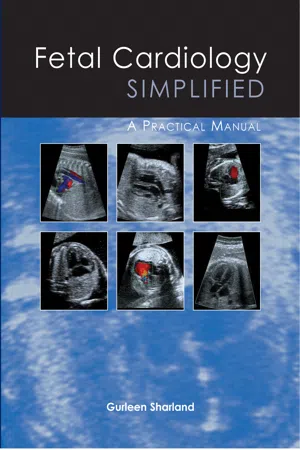
- English
- ePUB (mobile friendly)
- Available on iOS & Android
About this book
Fetal cardiology has developed dramatically into a subspecialty in the past 25 years. The majority of people examining the fetal heart are not 'experts' in fetal cardiology and therefore find interpreting images, particularly in case of abnormality, rather difficult. This book is designed as a practical guide, to be kept near the ultrasound machine, for all those performing fetal heart scans, but without the expertise of a fetal cardiologist. The aim is to allow the user to recognize the common forms of fetal cardiac abnormality and to appreciate the associated lesions and outcome. The book has a large number of illustrations to enable the reader to visualize the different types of problem and the various forms in which they may manifest. There are relatively few books published in the field of fetal cardiology. This book is aimed at all sonographers, obstetricians and radiologists performing obstetric ultrasound scans and at paediatric cardiologists, both at consultant and trainee level. Thus, this book should fulfill this unmet need in the market, although it is not designed as a comprehensive reference textbook in fetal cardiology.
Frequently asked questions
- Essential is ideal for learners and professionals who enjoy exploring a wide range of subjects. Access the Essential Library with 800,000+ trusted titles and best-sellers across business, personal growth, and the humanities. Includes unlimited reading time and Standard Read Aloud voice.
- Complete: Perfect for advanced learners and researchers needing full, unrestricted access. Unlock 1.4M+ books across hundreds of subjects, including academic and specialized titles. The Complete Plan also includes advanced features like Premium Read Aloud and Research Assistant.
Please note we cannot support devices running on iOS 13 and Android 7 or earlier. Learn more about using the app.
Information

Chapter 1
Summary
 | Introduction |
 | Prenatal detection of congenital heart disease |
| • | Screening for fetal congenital heart disease |
| • | Factors influencing screening of low-risk populations |
| • | Spectrum of abnormality detected prenatally |
 | Referral reasons for fetal echocardiography |
 | Gestational age at diagnosis |
Introduction
Prenatal detection of congenital heart disease
Screening for fetal congenital heart disease
Factors influencing antenatal screening for heart defects
Spectrum of abnormality detected in the fetus
Table of contents
- Cover Page
- Title Page
- Copyright Page
- Contents
- Foreword
- Acknowledgements
- Dedication
- Abbreviations
- Chapter 1: Screening for congenital heart disease
- Chapter 2: The normal fetal heart
- Chapter 3: Abnormalities of cardiac size, position and situs
- Chapter 4: Abnormalities of the four-chamber view (I) Abnormalities of veno-atrial and atrioventricular connection
- Chapter 5: Abnormalities of the four-chamber view (II) Abnormalities of atrioventricular valves and the ventricular septum with normal connections
- Chapter 6: Abnormalities of the four-chamber view (III) Obstructive lesions at the ventriculo-arterial junction that may be associated with an abnormal four-chamber view
- Chapter 7: Great Artery Abnormalities (I) Abnormalities of ventriculo-arterial connection
- Chapter 8: Great Artery Abnormalities (II) Abnormalities of ventriculo-arterial connection
- Chapter 9: Aortic arch abnormalities
- Chapter 10: Cardiomyopathies
- Chapter 11: Cardiac tumours
- Chapter 12: Other cardiac anomalies
- Chapter 13: Rhythm disturbances in the fetus
- Chapter 14: Counselling and outcome following prenatal diagnosis of congenital heart disease
- Chapter 15: What could cardiac findings mean?
- Further reading
- Index